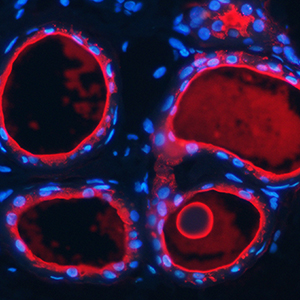Differential antigen expression between human apocrine sweat glands and eccrine sweat glands

Accepted: 29 November 2022
HTML: 42
All claims expressed in this article are solely those of the authors and do not necessarily represent those of their affiliated organizations, or those of the publisher, the editors and the reviewers. Any product that may be evaluated in this article or claim that may be made by its manufacturer is not guaranteed or endorsed by the publisher.
Authors
Bromhidrosis has a great negative impact on personal occupation and social psychology. It is not yet clear whether bromhidrosis is caused by apocrine sweat glands or the co-action of apocrine sweat glands and eccrine sweat glands. To distinguish between apocrine sweat glands and eccrine sweat glands, specific antigen markers for apocrine sweat glands and eccrine sweat glands must be found first. In the study, we detected the expression of K7, K18, K19, Na+-K+-2Cl- cotransporter 1 (NKCC1), carbonic anhydrase II (CAII), Forkhead transcription factor a1 (Foxa1), homeobox transcription factor engrailed homeobox1 (En1), gross cystic disease fluid protein-15 (GCDFP-15), mucin-1 (MUC-1), cluster of differentiation 15 (CD15) and apolipoprotein (APOD) in eccrine sweat glands and apocrine sweat glands by immunofluorescence staining. The results showed that K7, K18, K19, Foxa1, GCDFP-15 and MUC-1 were expressed in both apocrine and eccrine sweat glands, CD15 and APOD were only expressed in apocrine sweat glands, and CAII, NKCC1 and En1 were only expressed in eccrine sweat glands. We conclude that CD15 and APOD can serve as specific markers for apocrine sweat glands, while CAII, NKCC1 and En1 can serve as specific markers for eccrine sweat glands to differentiate the two sweat glands.
Rights
82172231, 82172211, 81830064Department of Wound Repair; Institute of Wound Repair and Regeneration Medicine, Southern University of Science and Technology Hospital, Southern University of Science and Technology School of Medicine, Shenzhen, Guangdong, China
How to Cite

This work is licensed under a Creative Commons Attribution-NonCommercial 4.0 International License.
PAGEPress has chosen to apply the Creative Commons Attribution NonCommercial 4.0 International License (CC BY-NC 4.0) to all manuscripts to be published.

 https://doi.org/10.4081/ejh.2023.3559
https://doi.org/10.4081/ejh.2023.3559






